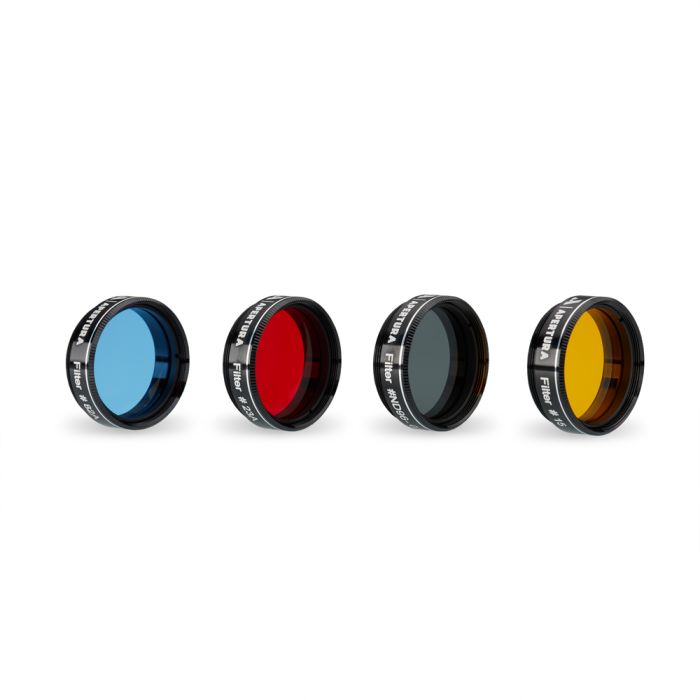Apertura 1.25" Lunar & Planetary Filter Set
Apertura Lunar & Planetary Kit #2
Includes Light Blue, Light Red, Yellow and ND96 1.25” Filters
This 4-piece Apertura 1.25” filter set includes the 82A Light (Pale) Blue, 15 Yellow, 23 Light Red, and a Neutral Density ND96 Filter in a plastic storage container. All of these filters transmit enough light to use with a wide range of telescopes and observations, although your mileage may vary depending on the telescope, eyepiece used, object observed, and the seeing conditions at the time.
Colored filters can be an invaluable aid in lunar and planetary observing. They reduce glare and light scattering, increase contrast through selective filtration, increase definition and resolution, reduce irradiation and lessen eye fatigue.
82A Light Blue Filter - 73% Transmission - A blue filter is useful for observations of the Great Red Spot on Jupiter, or to enhance the boundaries between the giant planet's reddish belts and their adjacent bright zones. A blue filter is also helpful when studying surface features and polar ice caps on Mars, or to improve Mercury's surface markings at twilight, when the elusive planet is low on the horizon. When observing Saturn, a blue filter will enhance low-contrast features, such as those found between the belts and zones. Checking out a comet? Use a blue filter to bring out definition in its gaseous tail.
23 Light Red Filter - 25% Transmission - A light red filter will help with daytime observations of Venus and Mercury by darkening the blue sky. When observing Jupiter and Saturn, you can expect a red filter to help you study clouds that have a bluish hue. Mars will also benefit from a red filter in several ways. It will reduce the light from blue and green areas, which darkens the maria, oases, and canal markings while lightening desert regions that are orangish in color. The 23A filter will also improve the definition of a comet's dust tail.
15 Yellow Filter - 67% Transmission - A yellow filter will enhance features on the Moon and Venus, and increase the definition in comet tails. When observing Jupiter and Saturn, you can expect a yellow filter to help you see the orange and reddish features of the belts and zones better and to penetrate and darken the subtle blue tones of the atmospheric currents. Mars will also benefit from a yellow filter in several ways. It will darken the maria, canal markings and oases, and at the same time, lighten the desert regions. A yellow filter will also sharpen the boundaries of Martian dust clouds. If you have a telescope with at least 11" of aperture, you can use a yellow filter to improve detail on both Neptune and Uranus.
Neutral Density ND96 Filter - A neutral density filter is great for looking at the Moon or other bright objects, such as Venus, without changing the color. It will dim the light coming to your eye so that you can see more detail. This ND Filter, which is sometimes called a Moon Filter for obvious reasons, has a density value of 0.9.
All of the Apertura 1.25” filters are made of high quality, solid plane parallel glass that has been anti-reflection coated to prevent glare and ghosting. They have a full 26mm clear aperture, and are mounted in a black anodized aluminum cell that is threaded on both sides to fit most eyepieces and stack with each other.


